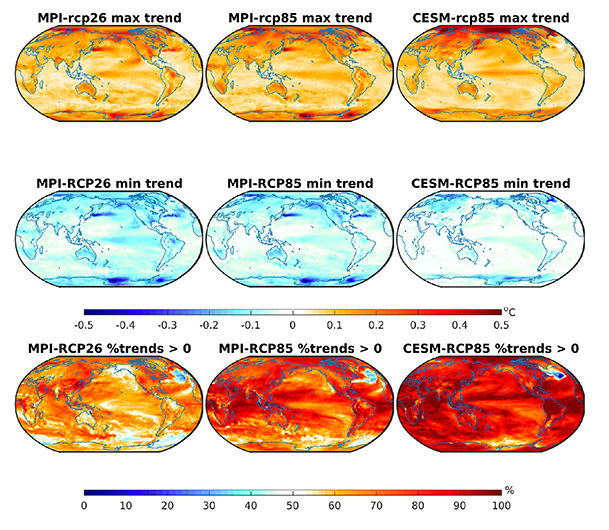Internal variability dominates short-term surface temperature trends
Internal variability or chaotic variability of the climate system can be described in terms of the ‘Butterfly Effect’, where a small change in the present can result in a much larger change in the future state. Single model initial-condition large ensembles (SMILEs) are global-coupled climate models which are run many times from slightly different initial conditions to capture the internal variability of the climate system and the range of possible futures that we could observe due to this chaos. For the first time Maher et al. utilise a new archive of six SMILEs as well as a large archive of single runs of many climate models (Coupled Model Intercomparison Project) to investigate the range trends that could be observed in the coming 15 years (2019-2034) (Figure).
They consider a high-mitigation low-warming scenario (RCP2.6) and a no-mitigation strong-warming scenario (RCP8.5). They find that the range of possible future trends is dominated by internal variability with little influence of which climate model is used or warming scenario followed. They find, somewhat counter intuitively, that even though greenhouse gases continue to increase in all scenarios, cooling (or a lack of warming) could be observed at any individual point on the globe in the coming 15 years (Figure; middle row). They do, however, also find that these cooling trends are less likely under strong warming than under the strong mitigation scenario (Figure; bottom row).

Original publication
Maher, N., Lehner, F., & Marotzke, J. (2020). Quantifying the role of internal variability in the climate we will observe in the coming decades. Environmental Research Letters, 15: 054014. doi:10.1088/1748-9326/ab7d02.
Contact
Dr Nicola Maher
Max Planck Institute for Meteorology
Email: nicola.maher@mpimet.mpg.de
Prof Jochem Marotzke
Max Planck Institute for Meteorology
Email: jochem.marotzke@mpimet.mpg.de
